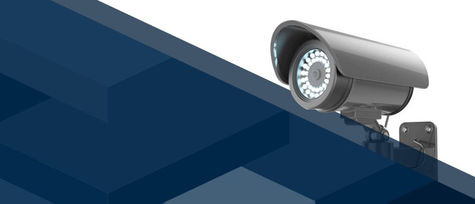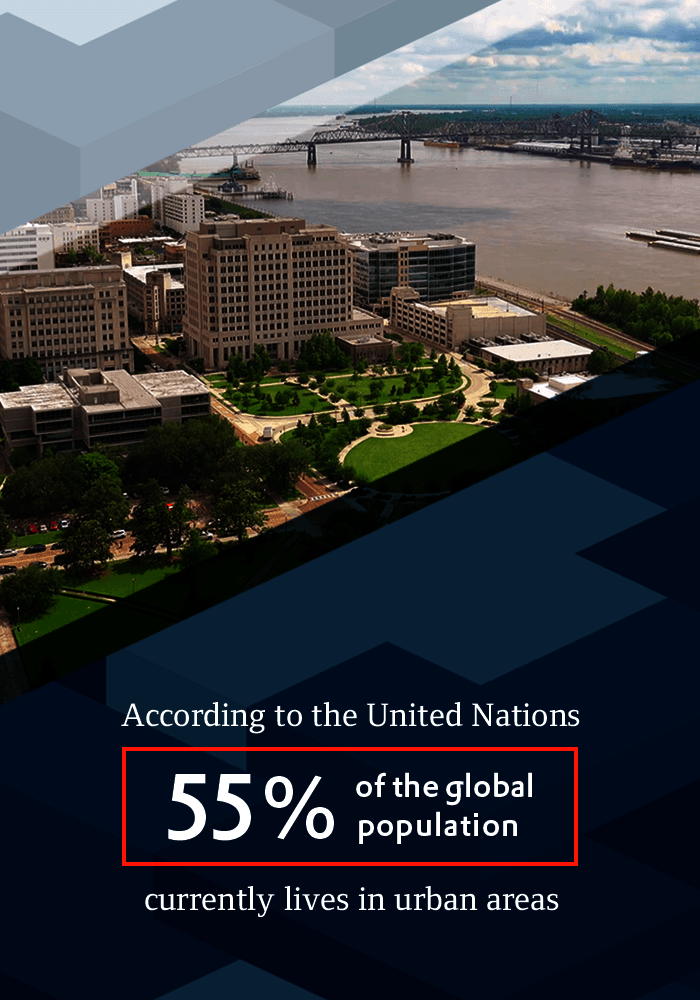How smart city technologies enable better living

Cities are getting smarter, and the shift toward more sustainable and intelligent cities helps improve living standards in urban and suburban communities around the world.
Energy savings, more efficient traffic flow, enhanced public safety and healthier environments are just a few of the many benefits smart city solutions can offer. Adoption of intelligent technologies to streamline these systems increases when governments – and the utilities and service providers in those municipalities, towns and cities – realize the benefits smart city solutions can bring.
Let's explore how smart city technologies and solutions can deliver solutions for better living.
What is a smart city and what makes it smart?
Smart cities are cities that use digital technology and data to improve decision-making and quality of life. They use smart technologies and solutions to gain a better understanding of current conditions, forecast future changes, optimize city functions and provide solutions.

How smart cities deliver solutions for better living
For a city, or any town or community, to become smart, it needs to have a critical mass of connected sensors, smartphones and other Internet of Things (IoT) devices. The connected devices can connect to the Internet and share the data they collect with city officials, engineers and other key administrators and managers. Managers of city systems can use various applications to take this data and turn it into information that they can use to accomplish tasks and optimize operations.
A city may manage its smart devices using a tool like the zenon Software Platform. zenon can help you to acquire data, visualize and analyze your data, manage your data, control systems and automate tasks. For example, you can use zenon in cooperation with other smart city technologies to detect leaks in water systems, manage energy use in buildings and control variable traffic signals.
7 ways smart city solutions can improve urban living and businesses
The vast array of possible smart city solutions can impact nearly every aspect of city life. Here's how smart cities improve living in seven different areas.
1. How smart cities save time
Connected technologies enable cities to run more efficiently, saving city officials, city employees, businesses and residents time.
You can apply products like zenon to a wide range of city projects and facilities. Standardizing the operation and control of your facilities can help save cities time and money in addition to making them more agile. For example, some cities use different software for different water or wastewater plants. If an employee needs to move to a different station, they need to learn the new system. If you have a standardized platform, operators can move between facilities with minimal need for additional training.
Improving travel within a city can have huge benefits for the economy and for quality of life. It saves people time, reduces frustration and enables people to access different parts of the city to patronize businesses and do things they enjoy more. A connected travel management system can help make travel more efficient for everyone who spends time in the city.
Using zenon, you can control variable traffic signs and create dynamic displays that show available parking spaces. Having connected systems enables you to remotely adjust signals during increased traffic volume. You can also analyze traffic patterns and optimize traffic light sequences to improve traffic flow.
2. How smart cities reduce costs
Smart city technologies enable cities to reduce their costs by helping them to conserve resources, including electricity, gas and water. An Energy Data Management System (EDMS) like zenon can automate the recording of energy usage data and enable intelligent systems control to improve energy efficiency. This capability is available for both new and existing buildings.
The zenon Software Platform allows you to, for example, automatically control the light levels, heating and cooling systems and external shades in a smart building based on weather conditions, solar radiation, occupancy plans and other factors. This optimized lighting reduces energy costs. Intelligent heating and cooling systems can automatically adjust the temperature to optimize energy usage. For example, the system could learn when a room is typically used and heat it only during those times, reducing energy waste. External window shades can retract if a strong wind is detected, preventing windows from damage and eliminating repair costs.
In addition, data from smart sensors can inform predictive maintenance strategies, which helps cities to repair equipment issues before they cause more expensive problems. This feature can be useful across public transportation systems, wastewater treatment plants and buildings.
3. How smart cities help the environment
Smart cities can also achieve sustainability by monitoring environmental conditions and controlling energy systems. Smart sensors can continually take air quality measurements, add that information to a database and automatically send warnings if pollutant levels get too high. This monitoring can help the city track progress on environmental goals and identify sources of pollution. If levels are exceptionally high in one area, the city may be able to use this information to identify pollution sources.
Smart technology can also help conserve resources, such as electricity, gas and water. Cities can use it to automatically optimize energy use in buildings through efficient control of heating and cooling systems, lighting and elevators. It can also help reduce water usage and help workers identify leaks in water pipes more quickly.
Smart city technology can also help cities to manage their electric grids more efficiently. zenon offers a variety of applications, including project configuration, visualization and reporting, that enable smart grids. You can use zenon to automate complex command sequences, improve situational awareness and quickly identify faults.
zenon can also help cities integrate renewable energy resources, energy storage systems and other resources, which can make their electric systems greener, into their grids. With zenon, you can manage, control and optimize renewable energy equipment, including solar, wind and hydropower plants. Distributed resources, such as rooftop solar, provide environmental benefits but can also make the grid more complex. Managing these resources from one central system like zenon and employing automation technologies can make managing distributed resources much easier.
Smart technologies also enable the integration of energy storage resources, which help make variable, clean resources such as wind and solar more valuable, into the grid. With a smart system, it becomes easier to visualize when and where stored energy is available and deploy it as needed.
4. How smart cities improve health
Health is a critical component of quality of life, and smart city technologies can help ensure that residents have the things they need to live a healthy life, including a healthy environment.

Internet-connected surveillance cameras and alarm systems can help deter theft and property damage and help find perpetrators afterwards.
Access to clean water is a key component of public health. Ensuring a continuous supply of clean water requires precise management of distribution and flow rate. zenon can help with this by using trend analysis to predict peaks in water usage, helping cities to prepare for them to avoid supply shortages. Predictive analytics enables utilities to identify components of the water system that are at risk of failure. Predicting these failures allows workers to fix the existing issues before they lead to a breakdown of the water supply or wastewater network.
Data analysis can be used similarly for energy infrastructure, helping cities to avoid blackouts. Loss of power can have health impacts, especially during times of extreme heat or cold.
Smart sensors can also monitor outdoor air quality, temperature and other parameters. If these sensors detect that one of these parameters has exceeded a predetermined limit, they can trigger an automated notification. City officials may then issue an air quality warning, heat advisory or other alerts. If these sensors regularly detect that pollutant levels are above the healthy limit, the city could use this information to take more long-term action.
5. How smart cities enhance safety
Smart city technologies can help improve safety through remote monitoring and control of important systems as well as alarms when problems occur.

zenon provides trend analysis to predict peaks in water usage, helping cities to prepare for them and avoid supply shortages.
IoT enables cities to connect security systems on buildings and in public spaces, allowing for more efficient monitoring and control of these systems. Internet-connected surveillance cameras, alarm systems and access controls can help deter theft, property damage and other crimes and help find perpetrators after a crime occurs. Remote monitoring of security systems can even help law enforcement to stop in-progress crimes more quickly. Cities can also install connected fire alarm systems and other warnings systems across buildings and public spaces.
Smart city technology can also help make roadways safer. In tunnel systems, connected fire alarms, ventilation systems and lighting can enable remote monitoring and alarms to ensure that the tunnels stay safe. City workers can also remotely control variable traffic signs and traffic light systems, sometimes with the help of automation. These systems help ensure a steady flow of traffic, and cities can use variable signage to warn drivers of hazards, reducing the likelihood of accidents occurring.
Ensuring a reliable supply of energy can also help improve safety for cities. Smart city systems can help operators to manage the electric grid in a way that minimizes blackouts. Connected energy infrastructure can supply early warnings of issues and enable more agile control of the grid. Cities can also use predictive analytics and smart city data to schedule maintenance work for energy infrastructure, helping the grid to function optimally.
6. How smart cities boost the economy
Becoming a smarter city can also help boost the local economy. Studies indicate that over the first five years of a city's transition to becoming a smart city, the benefits of the transition can boost GDP per capita by 21%.
Making a city smarter can position it as a technological leader and attract talent to the city. Smart tech creates jobs developing smart city projects, installing and maintaining smart equipment and more. Improving transportation can enable more people to participate in the economy because it becomes easier for them to travel for job opportunities.
In addition, smart technology can support businesses that play important roles in city economies. Shipping via rail, air, ships and other means, for example, creates jobs and enables the flow of goods. You can use smart city technologies to manage shipping traffic, optimize routes and enable predictive maintenance.
7. How smart cities encourage partnerships
Smart city technology may encourage partnerships between public and private entities, helping initiatives to get off the ground faster. Infrastructure investment traditionally locks governments into long-term, capital-intensive plans, but combining traditional construction with smart tech solutions can help cities be more agile in how they respond to changing demand. Cities can roll out smart city solutions one a time and update their systems as needed.
Many of the smart city initiatives that a government may launch could have a financially positive return, encouraging both government and private sector entities to fund them. More private sector involvement in these initiatives can promote creativity and increase adoption. While the government may run smart city programs in some cases, when the private sector launches them, the government may instead act as a regulator or offer financial support to existing programs through grants, subsidies and other means.
A look into the future of smart cities

According to the United Nations, 55% of the global population currently lives in urban areas, and by 2050, that number could increase to 68%. Cities will need smart solutions to support this growth. We can expect cities that adopt smart technologies – and use smart strategies to do so – will improve the quality of life of their residents and become leaders on the global stage.
The transition to smarter cities is already happening in many places around the world. According to a study, the global smart cities market will grow at a compound annual growth rate of 18.9% from 2019 to 2025 to reach $237.6 billion. This projected growth demonstrates how seriously cities are taking the transition to become smart cities. Over the coming years, we'll see many new smart cities and innovations emerge.
zenon for smart cities
Cities are becoming smarter and will continue to do so in the coming years. Smart city technology can result in better living by improving safety, health and the environment, reducing costs and boosting the economy.
To succeed in creating smart city initiatives, you need the right tools. Our software platform for industrial automation, zenon, provides features such as HMI, SCADA, IoT, IIoT, reporting, alarming and messaging in one integrated platform. The award-winning software platform can ease your digital transformation and allow you to automate, monitor, control and analyze operational processes. It's an ideal tool for enabling smarter energy, infrastructure, transportation, water management and buildings.
To learn more about zenon as well as our training and support services, continue to browse our solutions or contact us today.














































